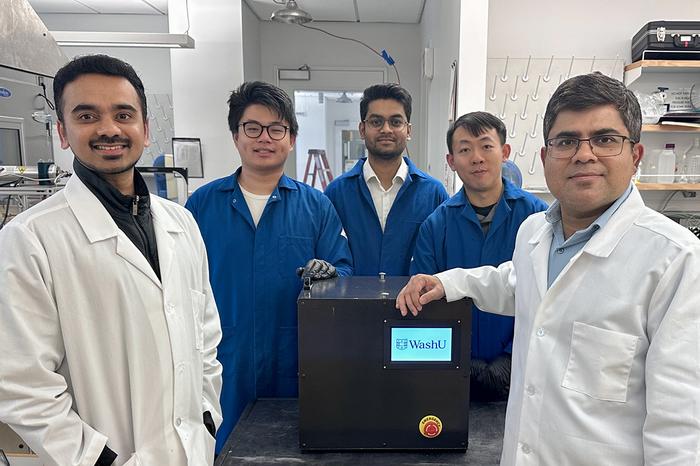The research team, led by Rajan Chakrabarty, a professor in the McKelvey School of Engineering at Washington University, has developed a novel biosensor that employs electrochemical capacitive technology. This biosensor enhances both the speed and sensitivity of pathogen detection, dramatically reducing the time it takes to identify dangerous viral threats from over 10 hours to just five minutes. Given the frightening mutations of H5N1, which have made the virus capable of transmission between birds and mammals, such rapid detection methods are crucial for outbreak containment.
In recent months, the rise in H5N1 cases among livestock has left farmers and public health authorities struggling to respond in a timely manner. This biosensor represents a proactive measure. It effectively tracks aerosolized virus particles, providing essential data on pathogen concentration levels present in farm environments. As the virus has evolved and adapted, it has manifested serious risks to other animals and even humans, making immediate and precise monitoring indispensable in safeguarding public health.
Chakrabarty, in discussing the capabilities of this groundbreaking technology, explained that the biosensor represents a first-of-its-kind innovation for detecting airborne microbial threats. Traditional detection methodologies often relied on PCR (polymerase chain reaction) techniques, which are notably slower and more labor-intensive. By changing the game with this new biosensor, scientists are empowering farmers to act swiftly upon obtaining crucial viral presence data without previously experienced delays.
The significant advancement in detection speed and efficiency allows for preparedness against potential outbreaks before they develop into widespread health crises. When H5N1 was initially detected, it primarily spread through contact with infected birds, but as it has mutated rapidly, necessitating new monitoring strategies. The supportive remarks from Chakrabarty highlight the urgency of their work and its alignment with the evolving landscape of zoonotic diseases.
The growing prevalence of H5N1, with recent reports of over 35 new dairy cattle cases spread across multiple states, underscores the relevance of this technology. The USDA’s Animal and Plant Health Inspection Service (APHIS) is closely monitoring these developments, and the importance of advanced biosensors could not be more critical. Farmers can send suspected infected animals for conventional testing, but the inherent delays in that process can be detrimental to early detection and effective containment strategies.
This biosensor’s operational efficiency is further enhanced by its compact design. It mirrors the dimensions of a desktop printer and can be strategically positioned at locations where farms vent exhaust from livestock housing. Its complex engineering includes a “wet cyclone bioaerosol sampler,” a technology adapted from previous research on aerosol sampling for SARS-CoV-2. This design enables high-velocity air samples to be drawn into the system and mixed with a specialized fluid that effectively captures airborne viral particles.
The technology is not just about detecting the presence of H5N1; it also preserves samples for additional analysis, a feature that allows for follow-up testing using traditional methods if necessary. The non-destructive nature of this biosensor makes it particularly useful—after identification, samples can still be processed, providing thorough insights into potential threats without compromising the integrity of the sample.
In a unique twist of research collaboration, graduate student Joshin Kumar and senior scientist Meng Wu have fine-tuned the electrochemical biosensor surface, improving its sensitivity to detect minuscule quantities of virus particles. Their innovative use of aptamers—single-stranded DNA that binds to viral proteins—addresses a major technical challenge in biosensor functionality.
Through relentless experimentation, the team has optimized the surface of the carbon electrode used in the biosensor. The innovative use of materials like graphene oxide and Prussian blue nanocrystals has increased the device’s sensitivity and stability significantly. The effective coupling of aptamers to the carbon surface using specific cross-linking agents has led to notable advances in detecting H5N1 at unprecedented levels of accuracy and efficiency.
Moreover, the biosensor’s ability to provide concentration ranges of pathogens in real-time signifies another pivotal milestone in sensor technology. Such capabilities offer not only immediate assessment but also help quantify threat levels within agricultural facilities. This development is a substantial leap in understanding pathogen dynamics and ensuring timely responses to potential outbreaks.
Looking ahead, the implications of this biosensor extend beyond just H5N1; its adaptable technology could be tailored to detect other strains of influenza, including the familiar H1N1, and even bacteriological threats like E. coli. The potential for scalability indicates an expansive application of this technology across various fields, from agriculture to public health.
The research team’s collaboration with Varro Life Sciences highlights the commitment to not only innovate but also to convert research progress into practical applications. Emphasizing the biosensor’s affordability and ease of production, Chakrabarty notes that it will allow for broader access in the agricultural sector, fundamentally altering how farmers engage with biosecurity.
In conclusion, the robust biosensor developed at Washington University truly represents a critical advancement in disease detection technology. As the landscape of pathogens continues to evolve, the tools we develop must likewise adapt, ensuring both animal and human health remain protected in a fast-paced world of emerging diseases. The advancements made through this biosensor are set to redefine how we monitor and respond to infectious threats in agricultural environments.
Subject of Research: Detection of H5N1 avian influenza using capacitive biosensors
Article Title: Rapid Detection of Avian Influenza H5N1 Through Novel Biosensor Technology
News Publication Date: October 2023
Web References: https://engineering.washu.edu/news/2023/Air-monitor-can-detect-COVID-19-virus-variants-in-about-5-minutes.html, https://ldh.la.gov/news/H5N1-death, https://www.aphis.usda.gov/livestock-poultry-disease/avian/avian-influenza/hpai-livestock
References: Kumar J, Xu M, Li YA, You SW, Doherty BM, Gardiner WD, Cirrito JR, Yuede CM, Benegal A, Vahey MD, Joshi A, Seehra K, Boon ACM, Huang YY, Puthussery JV, Chakrabarty R. Capacitive Biosensor for Rapid Detection of Avian (H5N1) Influenza and E. coli in Aerosols. ACS Sensors, online Feb. 21. DOI:
Image Credits: (Photo: Courtesy AIR lab.)
Keywords
Tags: advancements in breath sensing technologiesaerosol monitoring for virus detectionavian influenza detection technologyavian influenza impact on agricultureelectrochemical capacitive biosensorH5N1 virus transmission monitoringinnovations in pathogen detectionoutbreak containment strategies for poultrypublic health tools for virus monitoringrapid biosensor for H5N1real-time tracking of bird fluWashington University research on avian flu





